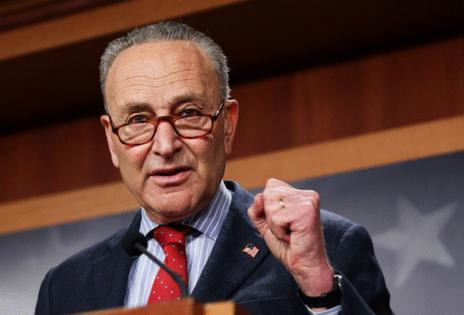Senate farm bill differs from House on CCC, food stamp benefits
Published in News & Features
WASHINGTON — The Senate Agriculture Committee on Monday released its long-awaited farm bill draft text with a little more than a month before funding for many farm programs dries up on Dec. 31.
The release of the Senate bill could ramp up action during the lame-duck session, but it remains to be seen if lawmakers can complete work on a new farm bill or opt for another extension of the existing one. Senate Majority Leader Charles E. Schumer last week urged Congress to make progress on the legislation.
This farm bill will be Senate Agriculture Chairwoman Debbie Stabenow’s last opportunity to shape farm and nutrition policy before her exit at the end of the 118th Congress.
“This is my vision,” Stabenow, D-Mich., said at a press briefing. “It’s important to me to put forward what I believe is a robust bill for farmers and ranchers.”
But the Senate bill still differs from the House bill in ways that may be difficult to overcome in the few legislative weeks available before the 118th Congress ends. The current law expired Sept. 30, but funds many programs through the calendar year.
The bills differ over the size of increases to the so-called farm safety net. Stabenow still says she opposes House Republican efforts to link food stamp benefits to inflation. Her bill also would restrict the Agriculture secretary’s use of Section 5 authority over the Commodity Credit Corporation, but for half the time House Republicans favor.
And both bills still need to be paid for. They would raise spending above the baseline and would need to find offsetting revenue or cost cuts — or get the budget committees to override the Congressional Budget Office score.
Stabenow said the bill has been “the most difficult to get serious negotiations to get it across the finish line.” The bill is her sixth as a senator and her third as a committee leader.
Negotiations between the chambers have been slow. The House Agriculture Committee approved its bill in May by a 33-21 vote, but it has yet to see any floor action.
“Despite the best efforts of the House committee to put forward what they wanted, they’ve not brought it to the floor since May because they don’t have the votes to do that,” Stabenow said. “So this can get bipartisan support, and our farmers, I think, would be thrilled to see the support that’s in this.”
Savings debate
Senate Democrats nevertheless moved toward the center on some issues.
The House bill would limit the flexibility of the Agriculture secretary to use the CCC’s Section 5 authority for 10 years, a move that Republicans say would deliver savings to pay for the bill.
Democrats had resisted the restriction, but Stabenow’s bill would restrict the Section 5 authority for five years. She said she told Republicans in October that she would be open to using the CCC to boost the bill’s baseline.
The CBO estimated that suspending the authority would save $5.4 billion over 2025-2034. That number falls well below the Republican estimate of more than $50 billion over 10 years. The House Agriculture Committee is seeking a directed score that would override the CBO to reflect the GOP estimate and smooth the bill’s passage.
Stabenow says her version will take the same approach. The Senate farm bill is $39 billion over the bill’s baseline. She says that money will come from restricting the CCC.
“What we’re doing is accepting their premise of CBO directed scoring to limit the CCC for five years,” she said. “I’m willing to push for that very hard, even though that’s not been done very often. But that’s what the House bill did.”
Restricting the CCC could also potentially check President-elect Donald Trump’s use of the agency to ease the potential burden of retaliatory tariffs on farmers in his second administration. Washington spent almost $30 billion in his first term for that purpose.
The nearly 1,400 page Senate bill would raise funding for the Price Loss Coverage and the Agriculture Risk Coverage programs, known as the farm safety net, by $20 billion, according to the summary.
The PLC and ARC both provide financial assistance to agricultural producers. The Senate bill would increase statutory reference prices by 5% for all covered commodities. The House bill would increase reference prices 10% to 20%.
The Senate bill would make it easier to trigger payments under those programs. It would also allow for partial or early payment for the ARC and PLC.
“One of the things that has been my concern all along with the focus on the commodity title and the two programs, ARC and PLC, is that they don’t pay out for at least a year-and-a-half after the costs. And right now, farmers are talking about immediate needs: input costs, other needs,” Stabenow said.
The chambers remain split on the Thrifty Food Plan, a tool for setting benefits under the Supplemental Nutrition Assistance Program. The House bill would keep the plan cost-neutral, a move that would effectively bar benefits from increasing or decreasing except to reflect the cost of living.
The CBO estimated that the provision would reduce direct spending by $35.6 billion over the 2025-2034 period. The House bill would use those funds to boost the farm safety net.
“I absolutely am not going to put my stamp on the largest cut in SNAP in 30 years, which is in the House bill,” Stabenow said.
The Senate panel hasn’t scheduled a markup and the bill has no Republican co-sponsors.
Ranking member John Boozman, R-Ark., who is in line to lead the committee next year, criticized the timing of the farm bill text release.
“An 11th hour partisan proposal released 415 days after the expiration of the current farm bill is insulting. America’s farmers deserve better,” Boozman said on the social media platform X.
_____
©2024 CQ-Roll Call, Inc., All Rights Reserved. Visit cqrollcall.com. Distributed by Tribune Content Agency, LLC.







Comments